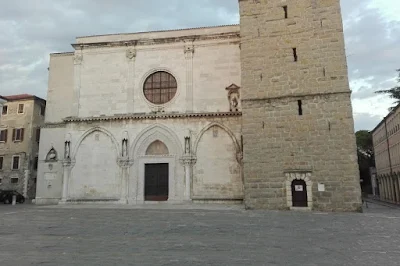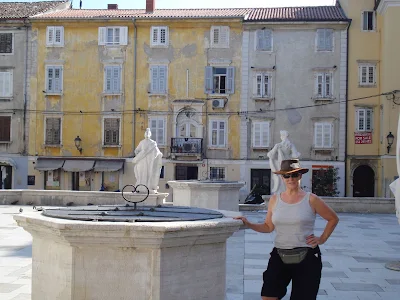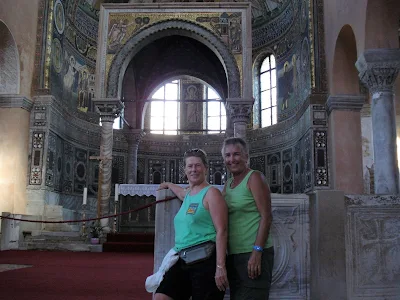 |
| Cathedral of
Assumption, Koper, Slovenian Istria |
We enjoyed our time in Italy, and are now
moving into Istria, the heart-shaped peninsular of land at the top of the
Adriatic Sea. It lies in the three countries of Italy, Slovenia and Croatia. We
are now moving out of the Italian part, into the Slovenian part.
Our first Slovenian town was Koper, the largest
coastal city in Slovenia. We had a
lovely drive around, then suddenly, we found that we were in a dead-end street
in the market area, in our big motorhome, Vanni.
 |
| Waterfront at Izola, Slovenian Istria |
A little embarrassed, Leigh stopped the
traffic, while Marg skilfully backed into a turning area, then out we went. Not
sure what the locals thought but they were very tolerant, and other drivers who
got out of our way never tooted once. We didn’t get to see as much of Koper as we would have liked.
Driving on, the next town we visited was Izola.
We managed to find a Vanni-size parking spot in the main street, but weren’t
sure that we could get out at the other end because the street was narrow, busy
and parked-out.
On our walking tour of the town, we
checked out the street width. In the end, we managed to fit through with no
problems, and drove on out to the other side of town.
 |
| Moon Bay, Strunjan, Slovenian Istria |
We liked Izola. It’s a small, pretty seaside
town, and it has lovely colourful houses built around the harbour.
We had a problem with Vanni’s size again in
Strunjan where we were trying to drive along a narrow 2-way street. We came
face to face with another car and there was not enough room for either of us to
pass, and there was a very large stream of traffic behind it and us.
We, being much bigger, waited for it to go over
the curb and onto the footpath so that we could get through. The trouble was,
the curb was far too high to drive over.
 |
| At Kamp Lucija, Portorož,
Slovenian Istria |
We couldn’t get enough swing room to mount the
curb either, and had nowhere to go. So, we reversed all the way back down the
street with Leigh moving the traffic behind us out of the way. Great fun (!)
and even more tolerant people. We didn’t get to see Strunjan township in the
end.
Unlike Italy, where there was usually
designated parking for big vehicles, the Slovenian towns do not cater for motorhomes.
 |
| Marg in Tartini Square, Piran, Slovenian Istria |
Deciding to get off the road, we found a lovely
campsite further on, in Portorož. It was Kamp Lucija, right on the beach front.
The camp was well situated and we were able to walk into Portorož township.
It’s a high-end summer resort, loaded with modern hotels and giant casinos
right next to its sandy beaches.
A few days later, we caught the local bus from
the campsite, into Piran. It’s lovely, and full of medieval Venetian style
houses huddled close together around the bay, and it has a beautiful piazza.
 |
| Leigh in Piran, Slovenian Istria |
We walked around the town’s fortifications,
which are very impressive, well preserved, and give great views of the area.
After that, we walked around more of the town, and found
a nice restaurant where we stopped for a beer.
Riding home on the bus, we were glad that we
didn’t have to find parking here - Vanni would certainly not have fitted into
this town!
We found this part of Slovenia to be very
beautiful, clean and sophisticated. Our next stop is the Croatian part of Istria,
which is actually the major part of the Istria Peninsular.
 |
| The harbour at Poreč,
Croatian Istria |
Istria, as in Roman times, is the food basket
for the three Istrian countries, and we drove past many fields of vegetables and
fruit, including olives and grapes.
They also make nice wine here. We particularly
enjoyed the style of white wine known as ‘malvazija’ which is a cross between a
chardonnay and pinot griggio.
The border into Croatia was just a short trip
out of Portorož so on we drove, south along the Istrian coast, stopping briefly at the Croatian towns of Savudrija and Umag.
 |
| Euphrasian Basilica,
Poreč (UNESCO) |
Then we arrived in Poreč. After all of our
parking difficulties on this leg of the trip, we were about to give up in
Poreč. But, following a few loops around the town, we found paid parking in a car
park. We then walked a little way in the 38 degree heat, to see the town.
Poreč is a lovely small town that is almost
2,000 years old, and set around a harbour. The compact town centre follows a
Roman street design and dates back to 50 BC.
 |
| Leigh in Rovinj |
In Marafor, the oldest part of the town, we saw the remains of the Temple of Mars and Neptune's Temple, both from Roman times, the Istrian Parliament Building which was once a Franciscan church, and lots of Venetian style architecture in the small narrow streets.
We visited several places, including an amazing
Euphrasian Basilica which is a UNESCO World Heritage Site because of its
fabulous mosaics. We toured this (including testing our leg muscles up and down
a very high bell tower), and it was just amazing, and so, so old (6 century
BC).
 |
| Vanni at Bi-Camping, Fažana, Croatian Istria |
We had a really delicious seafood lunch in a
relatively non-touristy part of town that had shade, and was on the waterfront.
At the end of our sightseeing, we returned to the van to find that the parking
man had gone off for his siesta, and we ended up parking for free. We liked
Poreč.
Rovinj was our next stop and again, we had
parking problems. We were moved on twice by a parking chappie on a scooter,
before he patiently led us to a bus parking area. This was great except that it
was quite a trek into town in the heat. It was worth it though, because Rovinj
is very pretty.
 |
| Leigh in Fažana, Croatian Istria |
Established by the Romans, it’s now a very
compact medieval town that sits on a small peninsular, jutting into the
Adriatic Sea.
Its buildings are densely clustered around the harbour, with some
looking like they have actually grown out of the ocean.
By this time, we were getting a bit tired, so
drove on to nearby Pula for the night. We found a very large campsite there called Bi-Camping, right
on the beach-front in the little Pula village of Fažana.
Our parking spot was facing the beachfront, and under the shade of old pines, so we had shade and a great view.
 |
| The Roman temple of Augustus in Pula, Croatian Istria |
We liked it so much there, that we stayed for a
week and spent our time swimming in the crystal-clear sea water, walking,
reading and visiting the village of Fažana.
This small village has a fantastic waterfront,
lovely gardens and many (given its small size) cafes and restaurants.
A few days later, we caught the local bus from Fažana into Pula.
Pula used to be an important naval port under the Austro-Hungarian Empire. It has a fairly authentic old town, and a lovely harbour.
We saw several key sights in Pula, including the subterranean caverns, the old city gates, and several very old churches.
Pula also has some Roman ruins. We had a good look around the various ruins, and saw a wonderful Roman amphitheatre that in our view, rivals the Coliseum in
Rome.
Looking further, we found, and really liked, the huge and majestic looking Roman Temple of Augustus. Augustus, was the first Roman emperor, and it's estimated that it was built at some point in his lifetime, between 27 BC and
his death in AD 14.
 |
| Views over the Gulf of Kvarner, Croatian Istria |
Back at the campsite, the weather continued to be very hot and
everyone lazed on the beach.
We had a group of 3 German couples who sat on the beach each
day, right opposite our camping place.
They were very friendly. At one point, Marg had
her family on Skype. She took her computer to the
beachfront to show them our lovely view. The German’s noticed and chatted to us, and shortly became our best buddies.
On our last morning, they came by on their
bicycles to say goodbye to us – nice people.
We had a spectacular storm while we were there,
with lots of thunder and lightning. A huge wind blew in off the sea and took us
unawares, and we nearly lost our awning. Luckily for us, the guy next door
helped us fold it, and all was well.
A few days later, we were ready to move on, so
we packed up and drove up the coast on the other side of Croatian Istria.
We passed through several lovely seaside towns.
We particularly liked Brestova for the views of the Gulf of Kvarner; Moscenicka
Draga for its lovely little beach and village; Lovran for its beautiful
architecture, town layout and focus on the bay, and Opatija for the same
(although not quite as attractive as Lovran).
Opatija was our last stop in Istria. We were
still heading north, planning to see more of Slovenia.